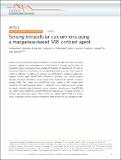| dc.contributor.author | Barandov, Ali | |
| dc.contributor.author | Bartelle, Benjamin B. | |
| dc.contributor.author | Williamson, Catherine G. | |
| dc.contributor.author | Loucks, Emily S. | |
| dc.contributor.author | Lippard, Stephen J. | |
| dc.contributor.author | Jasanoff, Alan | |
| dc.date.accessioned | 2022-06-13T15:08:52Z | |
| dc.date.available | 2021-10-27T20:11:00Z | |
| dc.date.available | 2022-06-13T15:08:52Z | |
| dc.date.issued | 2019-02 | |
| dc.date.submitted | 2018-07 | |
| dc.identifier.issn | 2041-1723 | |
| dc.identifier.uri | https://hdl.handle.net/1721.1/135156.2 | |
| dc.description.abstract | © 2019, The Author(s). Calcium ions are essential to signal transduction in virtually all cells, where they coordinate processes ranging from embryogenesis to neural function. Although optical probes for intracellular calcium imaging have been available for decades, the development of probes for noninvasive detection of intracellular calcium signaling in deep tissue and intact organisms remains a challenge. To address this problem, we synthesized a manganese-based paramagnetic contrast agent, ManICS1-AM, designed to permeate cells, undergo esterase cleavage, and allow intracellular calcium levels to be monitored by magnetic resonance imaging (MRI). Cells loaded with ManICS1-AM show changes in MRI contrast when stimulated with pharmacological agents or optogenetic tools; responses directly parallel the signals obtained using fluorescent calcium indicators. Introduction of ManICS1-AM into rodent brains furthermore permits MRI-based measurement of neural activation in optically inaccessible brain regions. These results thus validate ManICS1-AM as a calcium sensor compatible with the extensive penetration depth and field of view afforded by MRI. | en_US |
| dc.language.iso | en | |
| dc.publisher | Springer Science and Business Media LLC | en_US |
| dc.relation.isversionof | http://dx.doi.org/10.1038/s41467-019-08558-7 | en_US |
| dc.rights | Creative Commons Attribution 4.0 International license | en_US |
| dc.rights.uri | https://creativecommons.org/licenses/by/4.0/ | en_US |
| dc.source | Nature | en_US |
| dc.title | Sensing intracellular calcium ions using a manganese-based MRI contrast agent | en_US |
| dc.type | Article | en_US |
| dc.contributor.department | Massachusetts Institute of Technology. Department of Biological Engineering | |
| dc.contributor.department | Massachusetts Institute of Technology. Department of Chemistry | |
| dc.contributor.department | Massachusetts Institute of Technology. Department of Brain and Cognitive Sciences | |
| dc.contributor.department | Massachusetts Institute of Technology. Department of Nuclear Science and Engineering | |
| dc.relation.journal | Nature Communications | en_US |
| dc.eprint.version | Final published version | en_US |
| dc.type.uri | http://purl.org/eprint/type/JournalArticle | en_US |
| eprint.status | http://purl.org/eprint/status/PeerReviewed | en_US |
| dc.date.updated | 2019-07-18T14:53:24Z | |
| dspace.orderedauthors | Barandov, A; Bartelle, BB; Williamson, CG; Loucks, ES; Lippard, SJ; Jasanoff, A | en_US |
| dspace.date.submission | 2019-07-18T14:53:25Z | |
| mit.journal.volume | 10 | en_US |
| mit.journal.issue | 1 | en_US |
| mit.metadata.status | Authority Work Needed | en_US |
